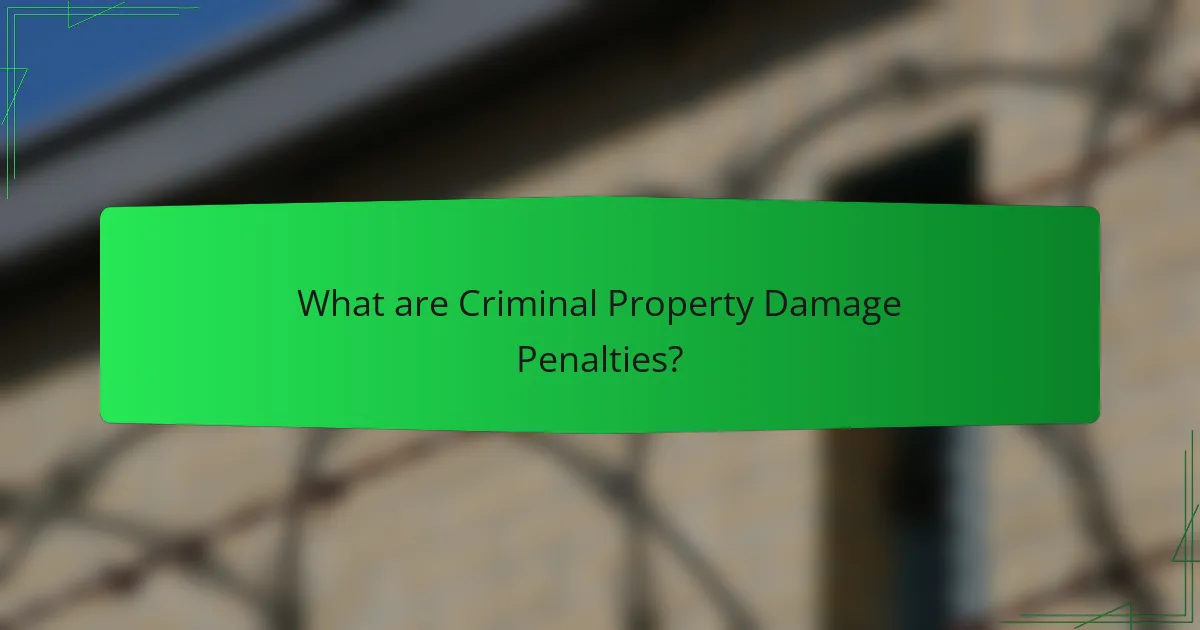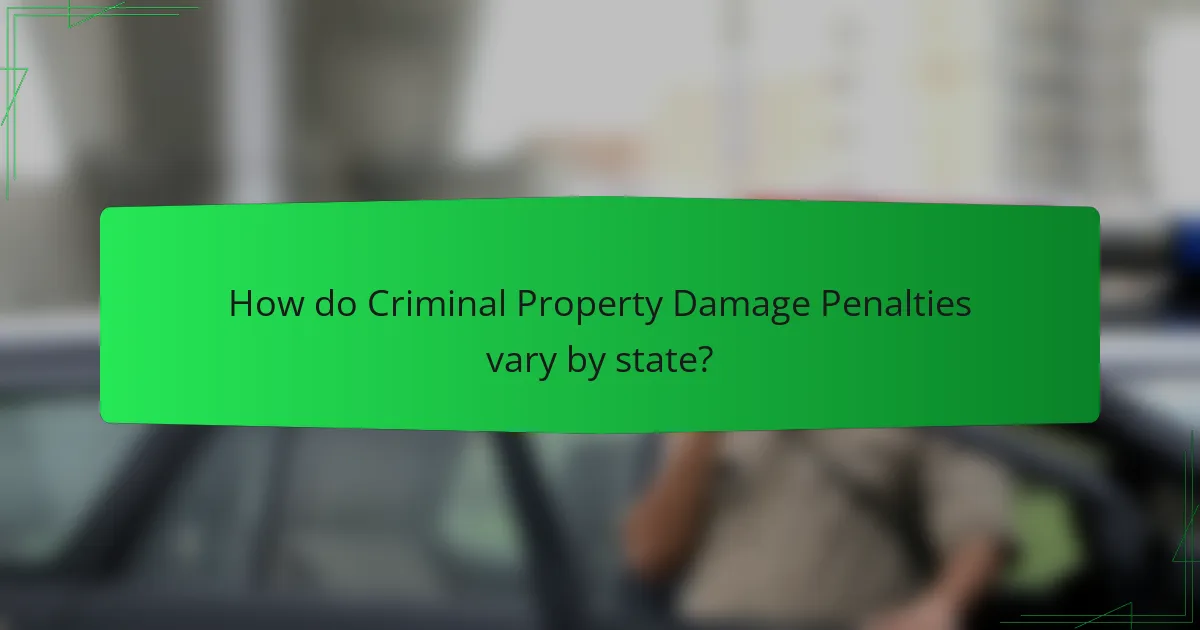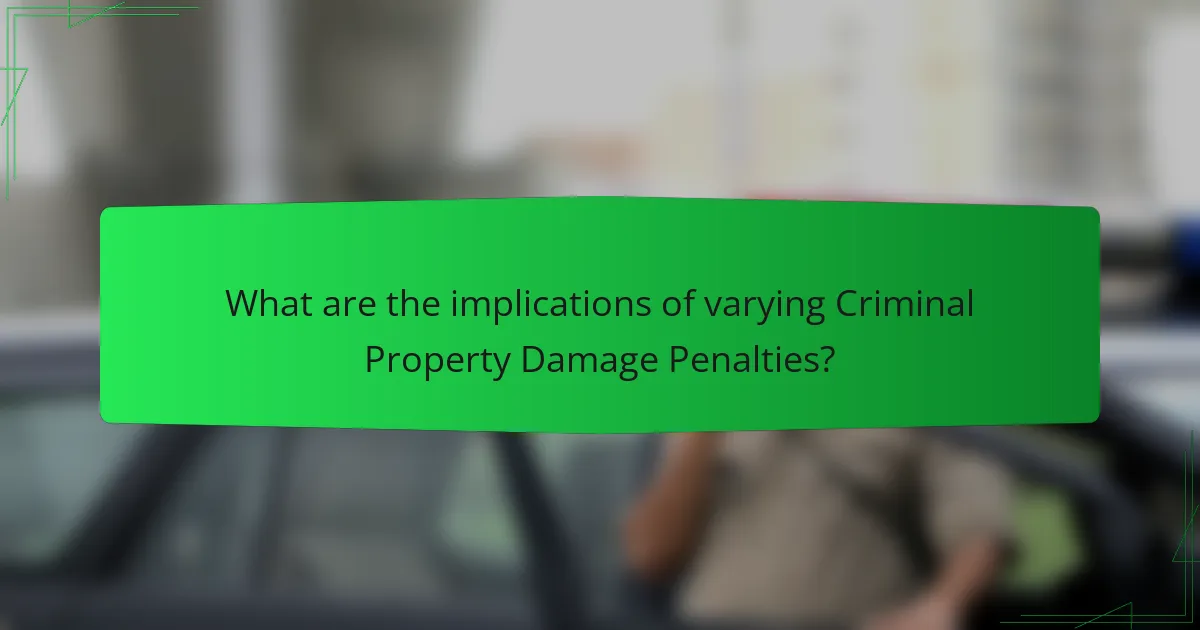Criminal property damage penalties refer to the legal consequences imposed on individuals who cause damage to property, and these penalties can vary significantly by state and local jurisdiction. The article examines how penalties typically include fines, restitution, and imprisonment, with the severity of the penalties often depending on the extent of the damage. It highlights differences in definitions and classifications of property damage across states, such as California, Texas, and Florida, which influence the legal outcomes for offenders. Additionally, the article discusses how varying penalties can impact criminal behavior and community safety, suggesting a correlation between stricter penalties and lower rates of property damage crimes. Overall, the content provides a comprehensive overview of the legal landscape surrounding criminal property damage across different jurisdictions.

What are Criminal Property Damage Penalties?
Criminal property damage penalties vary by jurisdiction. Typically, penalties include fines, restitution, and imprisonment. The severity of penalties often depends on the extent of the damage. For example, minor damage may result in a misdemeanor charge. This can lead to fines up to $1,000 and possible jail time. Major damage may incur felony charges. Felony charges can result in fines exceeding $10,000 and several years of imprisonment. Some states also impose community service or probation as additional penalties. Specific laws and penalties can differ significantly across states and localities.
How are Criminal Property Damage Penalties defined across different jurisdictions?
Criminal property damage penalties vary significantly across different jurisdictions. Each state defines property damage in its penal code, specifying the severity of the offense. For instance, some jurisdictions classify property damage as a misdemeanor for minor offenses, resulting in fines or short jail time. Other areas may escalate the offense to a felony for severe damage, leading to longer imprisonment and higher fines.
In California, for example, vandalism causing damage over $400 is considered a felony, while damage below that threshold is a misdemeanor. Conversely, in Texas, criminal mischief penalties depend on the amount of damage, with amounts over $2,500 leading to felony charges.
Additionally, local ordinances can impose stricter penalties than state laws. Therefore, it is crucial to consult specific state and local laws for precise definitions and penalties related to criminal property damage.
What legal frameworks govern Criminal Property Damage Penalties?
Criminal property damage penalties are governed by state laws and local ordinances. Each state has its own criminal code that defines property damage offenses and corresponding penalties. These laws vary significantly across jurisdictions. For example, some states categorize property damage as a misdemeanor while others classify it as a felony, depending on the damage amount. Local jurisdictions may impose additional regulations or penalties. Courts interpret these laws based on statutory language and precedents. Legal frameworks also consider factors such as intent and prior offenses. Understanding these frameworks is essential for determining liability and penalties in property damage cases.
What factors influence the severity of penalties for property damage?
The severity of penalties for property damage is influenced by several key factors. These factors include the extent of the damage caused, which determines the financial impact on the victim. The intent behind the damage also plays a crucial role; intentional acts typically incur harsher penalties than accidental damage. The previous criminal record of the offender can elevate the severity of the penalty, especially for repeat offenders. Additionally, the type of property damaged, such as residential versus commercial, may affect the penalty. Jurisdictional laws vary significantly, leading to differences in penalties based on local regulations. Finally, aggravating circumstances, such as the use of dangerous weapons or involvement of minors, can result in increased penalties.
What types of property damage are covered under criminal penalties?
Criminal penalties cover various types of property damage. These include vandalism, which involves defacing or destroying property. Burglary also falls under this category when property is damaged during unlawful entry. Arson is a serious offense that involves intentionally setting fire to property. Trespassing can lead to property damage if entry results in harm to the premises. Additionally, malicious mischief covers acts intended to cause damage. Each type is subject to specific laws that vary by state and local jurisdiction. Penalties can include fines, restitution, and imprisonment based on the severity of the damage.
How do state laws differentiate between types of property damage?
State laws differentiate between types of property damage by categorizing them into various classifications. Common classifications include intentional damage, negligent damage, and accidental damage. Intentional damage involves purposeful actions that harm property, such as vandalism. Negligent damage occurs when a person’s failure to act responsibly leads to property harm. Accidental damage is unintentional and often results from unforeseen events. Each state has specific statutes that outline penalties for these classifications. For example, intentional damage may carry harsher penalties than accidental damage. This differentiation helps legal systems address the intent and circumstances surrounding property damage incidents.
What are examples of criminal property damage cases?
Examples of criminal property damage cases include vandalism, arson, and graffiti. Vandalism involves the intentional destruction of property, such as breaking windows or damaging vehicles. Arson refers to the deliberate setting of fires to property, which can cause extensive damage. Graffiti is the act of marking or painting on property without permission, often viewed as defacement. Each of these acts can lead to criminal charges and penalties, varying by state and local laws. For instance, in California, vandalism can result in fines and imprisonment depending on the damage value.

How do Criminal Property Damage Penalties vary by state?
Criminal property damage penalties vary significantly by state. Each state defines property damage differently, affecting the severity of penalties. For example, in California, penalties can range from fines to imprisonment based on the damage amount. In Texas, penalties depend on whether the damage exceeds $2,500, with higher consequences for greater amounts. Florida categorizes property damage into misdemeanors and felonies, influencing sentencing options. States like New York impose harsher penalties for damage to specific types of property, such as vehicles or public infrastructure. Additionally, some states have unique provisions for repeat offenders, which can increase penalties further. Overall, the variations reflect differing state laws and priorities regarding property protection.
What are the key differences in penalties for property damage across states?
Penalties for property damage vary significantly across states. In some states, property damage is classified as a misdemeanor, resulting in fines up to $1,000 and possible jail time. Other states categorize it as a felony, leading to fines exceeding $5,000 and longer imprisonment. For example, California imposes penalties based on the amount of damage, with higher costs resulting in harsher consequences. In contrast, Texas has a tiered system where damage amounts dictate whether the charge is a misdemeanor or felony. Additionally, states like Florida have specific laws for vandalism, which can include community service as part of the penalty. The differences reflect each state’s legal framework and priorities regarding property protection.
How do state laws classify property damage offenses?
State laws classify property damage offenses primarily as misdemeanors or felonies. Misdemeanor property damage typically involves lower monetary thresholds for damage, often resulting in fines or short-term imprisonment. Felony classifications arise from higher damage amounts or circumstances that aggravate the offense, such as intent to harm. Each state sets specific dollar amounts that determine the classification. For instance, in California, damage exceeding $400 is classified as a felony. In contrast, states like Texas classify damage over $2,500 as a felony. This classification system helps to standardize penalties and enforcement across jurisdictions.
What are the minimum and maximum penalties for property damage in various states?
The minimum and maximum penalties for property damage vary significantly by state. In California, penalties range from a minimum of $100 to a maximum of $1,000 for misdemeanor offenses. In Texas, the minimum penalty can be as low as $50, while the maximum can reach $10,000 depending on the extent of the damage. Florida imposes penalties starting at $250 for misdemeanors, with maximum fines up to $15,000 for felony charges. New York has a minimum penalty of $300 and can escalate to $5,000 for more severe offenses. Each state has specific laws that outline these penalties based on the value of the damaged property and the circumstances of the offense.
What role do local jurisdictions play in determining penalties?
Local jurisdictions play a critical role in determining penalties for criminal property damage. They establish specific laws and regulations that can vary significantly from one area to another. Local governments have the authority to define what constitutes criminal property damage within their boundaries. This includes setting the severity of penalties for different types of damage. For instance, a city may impose stricter fines or community service requirements than a neighboring municipality. Additionally, local jurisdictions can influence the enforcement of these penalties through their law enforcement agencies. This localized approach allows for a tailored response to community standards and needs. The differences in penalties across jurisdictions highlight the importance of local governance in the criminal justice system.
How do local laws impact state penalties for property damage?
Local laws can significantly influence state penalties for property damage. They may establish specific definitions of property damage that differ from state laws. Local jurisdictions often have their own ordinances that dictate penalties, which can be more severe or lenient than state laws. For example, a city might impose higher fines for vandalism than the state minimum. Additionally, local laws can determine the circumstances under which penalties are applied, such as aggravating factors like repeat offenses. This creates a patchwork of legal consequences that varies widely across different areas. Therefore, individuals may face different penalties for the same act of property damage depending on local regulations.
What are some notable local variations in property damage penalties?
Notable local variations in property damage penalties exist across different jurisdictions. For instance, California imposes fines ranging from $1,000 to $10,000 for vandalism depending on the extent of damage. In contrast, Texas may charge individuals with penalties up to $4,000 for similar offenses. New York has a tiered system where damages under $250 result in misdemeanor charges, while damages exceeding that amount can lead to felony charges. Additionally, Florida has a unique provision where community service can be mandated alongside fines for property damage. These variations reflect local laws and the severity of the offense.

What are the implications of varying Criminal Property Damage Penalties?
Varying Criminal Property Damage Penalties can lead to significant differences in legal outcomes and deterrence. Different states and local jurisdictions impose distinct penalties based on the severity of the damage. For instance, penalties may range from fines to imprisonment, affecting the offender’s future. These variations can influence criminal behavior, as harsher penalties may deter potential offenders more effectively. Additionally, inconsistencies in penalties can create confusion among the public regarding legal consequences. Research indicates that jurisdictions with stricter penalties often report lower rates of property damage crimes. This suggests a correlation between penalty severity and crime rates. Overall, the implications of varying penalties are profound, impacting both legal systems and community safety.
How do variations in penalties affect individuals and businesses?
Variations in penalties for criminal property damage significantly impact individuals and businesses. Different states and local jurisdictions impose varying fines and sentences for similar offenses. Individuals may face harsher penalties in some areas, leading to increased financial strain and potential incarceration. Businesses can experience increased operational costs due to varying compliance requirements and potential legal liabilities. For example, a study by the National Conference of State Legislatures highlighted that penalties can range from fines of hundreds to thousands of dollars based on jurisdiction. This inconsistency can create confusion and challenges in legal compliance for both individuals and businesses.
What challenges do individuals face when navigating different state penalties?
Individuals face several challenges when navigating different state penalties for criminal property damage. Variations in laws across states create confusion. Each state has its own definitions and classifications for property damage offenses. This inconsistency can lead to misunderstandings about potential penalties. Lack of clear information about specific state laws complicates compliance. Individuals may struggle to find legal representation knowledgeable in their state’s laws. Additionally, differing enforcement practices can result in unpredictable outcomes. Penalties can vary significantly, ranging from fines to imprisonment, depending on the jurisdiction. This variability can create anxiety and uncertainty for those involved in legal proceedings.
How can businesses protect themselves from property damage penalties?
Businesses can protect themselves from property damage penalties by implementing comprehensive risk management strategies. These strategies include obtaining adequate insurance coverage to mitigate financial losses. Regular maintenance of property can prevent deterioration that leads to penalties. Training employees on proper handling of equipment reduces the risk of accidental damage. Establishing clear policies on property use can help in avoiding disputes. Documenting property conditions through photographs and reports provides evidence in case of claims. Engaging legal counsel for compliance with local regulations ensures adherence to laws that govern property management. These measures collectively create a robust defense against potential penalties.
What best practices can individuals follow to avoid penalties?
Individuals can avoid penalties by adhering to laws regarding property damage. Understanding local regulations is crucial, as they can vary significantly by jurisdiction. Regularly reviewing property maintenance can prevent inadvertent violations. Keeping records of property conditions can provide evidence of responsible ownership. Engaging in open communication with neighbors can foster goodwill and prevent disputes. Attending community meetings can help individuals stay informed about local laws. Seeking legal advice when unsure about property rights is also beneficial. Following these practices can significantly reduce the risk of penalties related to property damage.
What steps should be taken if accused of property damage?
If accused of property damage, first remain calm and gather information about the accusation. Identify the specific property involved and the nature of the damage claimed. Document your version of events in detail, noting dates, times, and witnesses. Collect any evidence that supports your case, such as photographs or videos. Reach out to legal counsel for advice tailored to your situation. Do not admit guilt or make statements that could be used against you. Lastly, respond to any formal notices or legal documents promptly to avoid further complications. These steps help protect your rights and ensure proper handling of the accusation.
How can one seek legal counsel regarding property damage charges?
To seek legal counsel regarding property damage charges, individuals should first identify attorneys specializing in property law or criminal defense. They can search online legal directories or contact local bar associations for referrals. Scheduling initial consultations can help assess the attorney’s experience and approach. It’s essential to prepare relevant documents and details about the case before meeting with the attorney. Engaging with a qualified attorney can provide guidance on legal rights and potential defenses. This process ensures informed decision-making in navigating property damage charges.
Criminal property damage penalties are legal consequences imposed for damaging another person’s property, varying significantly across different jurisdictions. This article examines the definitions, classifications, and factors influencing the severity of these penalties, including distinctions between misdemeanors and felonies based on damage amounts. It highlights the role of state laws, local ordinances, and specific examples of criminal property damage cases, as well as the implications of these variations for individuals and businesses. Additionally, it provides best practices for avoiding penalties and steps to take if accused of property damage.